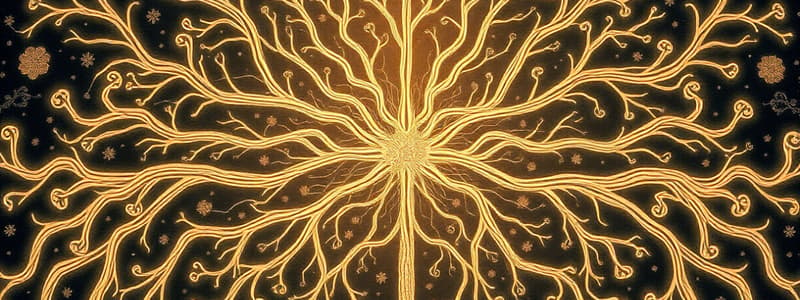Podcast
Questions and Answers
What is the primary function of the central nervous system?
What is the primary function of the central nervous system?
- Facilitating voluntary movements of skeletal muscles
- Processing sensory information and generating thoughts (correct)
- Regulating the hormonal activities of the body
- Transmitting sensory impulses to muscle tissue
Which component is NOT part of the peripheral nervous system?
Which component is NOT part of the peripheral nervous system?
- Cranial nerves
- Spinal nerves
- Neuroglia (correct)
- Neurons outside the CNS
What is a key distinction between the somatic and autonomic nervous systems?
What is a key distinction between the somatic and autonomic nervous systems?
- The autonomic nervous system includes cranial nerves.
- The somatic nervous system controls involuntary actions.
- The somatic nervous system is responsible for voluntary movements. (correct)
- The autonomic nervous system regulates voluntary muscle movement.
How does the peripheral nervous system primarily function in relation to the central nervous system?
How does the peripheral nervous system primarily function in relation to the central nervous system?
Which of the following statements best describes the role of neurons in the nervous system?
Which of the following statements best describes the role of neurons in the nervous system?
Which statement accurately describes the pathways of somatic and autonomic motor neurons?
Which statement accurately describes the pathways of somatic and autonomic motor neurons?
What distinguishes the neurotransmitter release between somatic and autonomic motor neurons?
What distinguishes the neurotransmitter release between somatic and autonomic motor neurons?
Which of the following accurately describes the control of motor output in somatic and autonomic systems?
Which of the following accurately describes the control of motor output in somatic and autonomic systems?
Where is the cell body of a preganglionic neuron located, and what characterizes its axon?
Where is the cell body of a preganglionic neuron located, and what characterizes its axon?
Which statement correctly compares the sensory input of the somatic and autonomic nervous systems?
Which statement correctly compares the sensory input of the somatic and autonomic nervous systems?
Flashcards
Central Nervous System (CNS)
Central Nervous System (CNS)
The control center of the nervous system, consisting of the brain and spinal cord. It processes sensory information, generates thoughts and emotions, and initiates muscle contractions and gland secretions.
Peripheral Nervous System (PNS)
Peripheral Nervous System (PNS)
The network of nerves that connects the CNS to the rest of the body. It carries sensory information to the CNS and motor commands from the CNS to muscles and glands.
Somatic Nervous System
Somatic Nervous System
The part of the PNS that controls voluntary movements of skeletal muscles. It receives commands from the CNS and transmits them to the muscles.
Autonomic Nervous System
Autonomic Nervous System
Signup and view all the flashcards
Reflex Arc
Reflex Arc
Signup and view all the flashcards
Preganglionic neuron
Preganglionic neuron
Signup and view all the flashcards
Postganglionic neuron
Postganglionic neuron
Signup and view all the flashcards
Autonomic ganglion
Autonomic ganglion
Signup and view all the flashcards
Acetylcholine (ACh)
Acetylcholine (ACh)
Signup and view all the flashcards
Norepinephrine (NE)
Norepinephrine (NE)
Signup and view all the flashcards
Study Notes
Nervous System Types and Subdivisions
- The nervous system controls bodily functions, faster than the endocrine system
- The nervous system's basic unit is the neuron
- It's divided into two main parts: Central Nervous System (CNS) and Peripheral Nervous System (PNS)
Central Nervous System (CNS)
- Includes the brain and spinal cord
- Processes sensory information
- Origin of thoughts, emotions, and memories
- Directs muscle contractions and gland secretions
Peripheral Nervous System (PNS)
- All nervous tissue outside the CNS
- Contains cranial nerves (12 pairs) arising from the brain, and spinal nerves (31 pairs) arising from the spinal cord
- Relays information to and from the central nervous system
- Divided into two subdivisions: Somatic and Autonomic nervous systems
Somatic Nervous System
- Controls voluntary muscle movements
- Sensory neurons receive input from touch, temperature, pain, and position sensors (proprioceptors), and the special senses (sight, hearing, taste, smell, balance)
- Motor neurons connect to skeletal muscles
- One neuron pathway
- Neurotransmitter: Acetylcholine (ACh)
Autonomic Nervous System
-
Concerned with regulating visceral functions (internal organs) like heart rate, blood pressure, digestion, body temperature, and reproduction
-
Involuntary
-
Consists of two divisions: Sympathetic and Parasympathetic divisions
-
Two-neuron pathway (preganglionic and postganglionic neurons)
-
Neurotransmitters: Acetylcholine (ACh) and Norepinephrine (NE)
-
Sympathetic division: involved with "fight-or-flight" responses, supporting exercise and emergency actions.
-
Parasympathetic division: involved with "rest-and-digest" activities, maintaining homeostasis
Studying That Suits You
Use AI to generate personalized quizzes and flashcards to suit your learning preferences.




